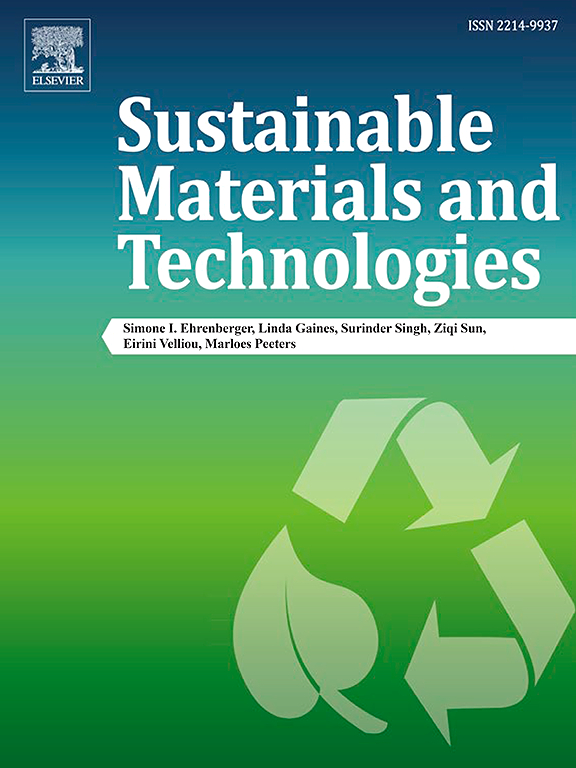Room-temperature 3D printing of recyclable polyimide dielectrics for high-frequency antenna applications
IF 9.2
2区 工程技术
Q1 ENERGY & FUELS
引用次数: 0
Abstract
Polyimides with ultralow dielectric permittivity and loss are essential for the production of advanced high-frequency wireless telecommunications systems. However, most polyimides produced through one-step high-temperature imidization and molding are thermosetting and incompatible with microelectronics manufacturing. Herein, we develop a vapor induced phase separation (VIPS) assisted direct ink writing process for the room-temperature fabrication of three-dimensional (3D) polyimide dielectrics. A simple yet effective ink formulation composed exclusively of soluble polyimide (sPI) and solvents is presented. Upon extrusion, the ink undergoes rapid gelation and solidification via VIPS triggered by ambient moisture, followed by solvent exchange in liquid water to form sPI filaments with dense skins and microporous cores. By programmably adjusting nozzle trajectories, the macroscopic features of the filaments can be precisely controlled, enabling the fabrication of 3D sPI dielectrics with a porosity of up to 87 %. These materials exhibit an ultralow permittivity of 1.32 and a loss tangent of 0.005 at 1 MHz, surpassing the performance of many existing dielectrics. The 3D dielectrics are applied in the fabrication of coplanar waveguide antennas and thermal management systems, demonstrating their potential for high-frequency communication and advanced electronics. Furthermore, the 3D sPI prints can be fully recycled by dissolving the products in solvents and reprocessing them into new ultralow-permittivity dielectrics, offering a sustainable and low-carbon manufacturing strategy for the microelectronics industry. This work not only overcomes the limitations of traditional polyimide processing but also provides a new platform for next-generation high-frequency communication and electronic devices.
用于高频天线应用的可回收聚酰亚胺电介质的室温3D打印
聚酰亚胺具有超低介电常数和损耗,是生产先进的高频无线通信系统必不可少的材料。然而,大多数通过一步高温亚胺化和模塑生产的聚酰亚胺是热固性的,与微电子制造不相容。在此,我们开发了一种蒸汽诱导相分离(VIPS)辅助直接墨水写入工艺,用于室温制造三维(3D)聚酰亚胺电介质。提出了一种简单而有效的由可溶性聚酰亚胺(sPI)和溶剂组成的油墨配方。挤出后,油墨通过环境湿度触发的VIPS快速凝胶和凝固,然后在液态水中进行溶剂交换,形成具有致密表皮和微孔芯的sPI细丝。通过可编程调节喷嘴轨迹,可以精确控制细丝的宏观特征,从而制造出孔隙率高达87%的3D sPI介电材料。这些材料在1 MHz时具有1.32的超低介电常数和0.005的损耗正切,超过了许多现有介电材料的性能。3D介质被应用于共面波导天线和热管理系统的制造,展示了它们在高频通信和先进电子领域的潜力。此外,3D sPI打印可以通过将产品溶解在溶剂中并将其重新加工成新的超低介电常数介质来完全回收,为微电子工业提供可持续和低碳的制造策略。这项工作不仅克服了传统聚酰亚胺加工的局限性,而且为下一代高频通信和电子设备提供了新的平台。
本文章由计算机程序翻译,如有差异,请以英文原文为准。
求助全文
约1分钟内获得全文
求助全文
来源期刊

Sustainable Materials and Technologies
Energy-Renewable Energy, Sustainability and the Environment
CiteScore
13.40
自引率
4.20%
发文量
158
审稿时长
45 days
期刊介绍:
Sustainable Materials and Technologies (SM&T), an international, cross-disciplinary, fully open access journal published by Elsevier, focuses on original full-length research articles and reviews. It covers applied or fundamental science of nano-, micro-, meso-, and macro-scale aspects of materials and technologies for sustainable development. SM&T gives special attention to contributions that bridge the knowledge gap between materials and system designs.
 求助内容:
求助内容: 应助结果提醒方式:
应助结果提醒方式:


